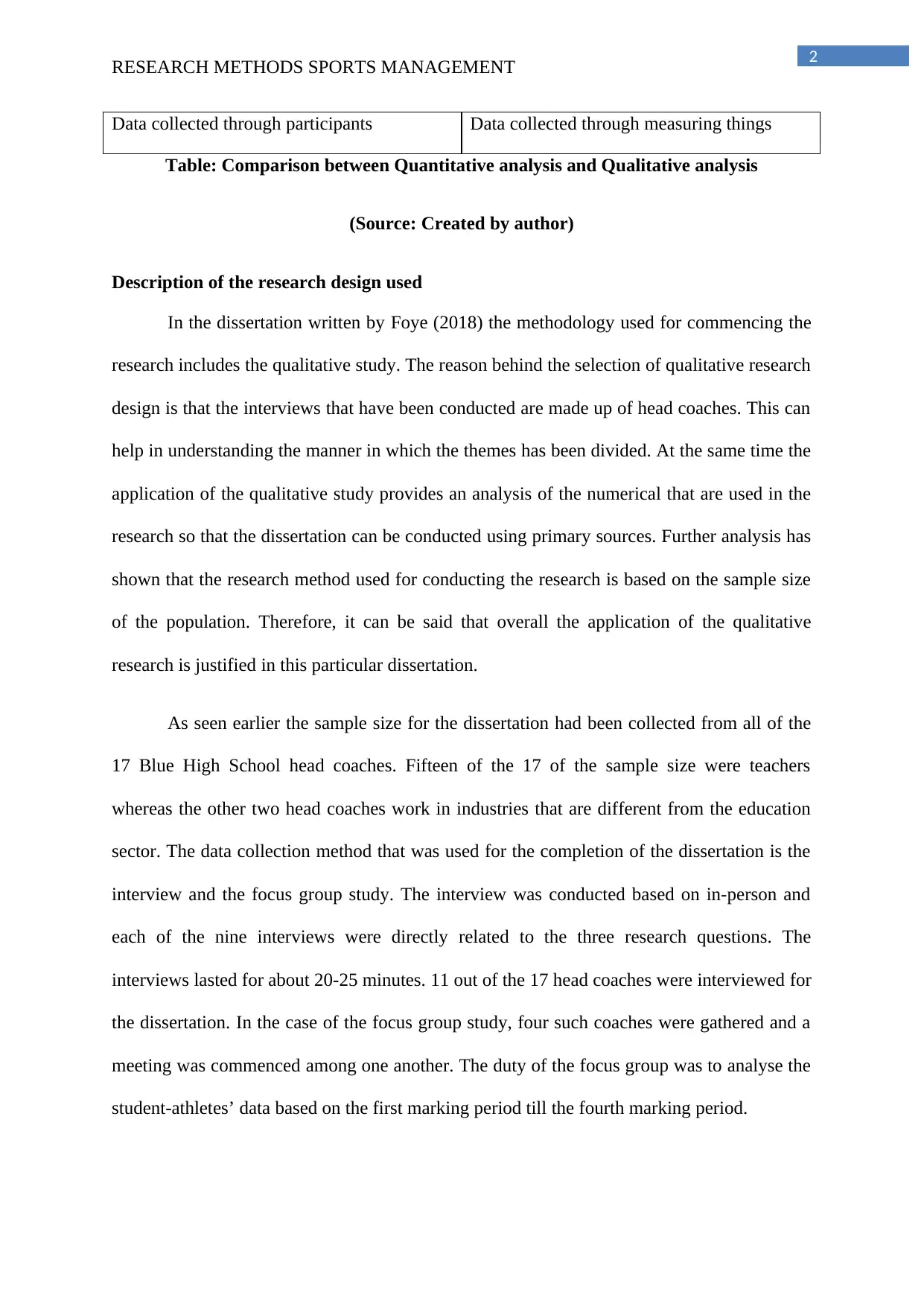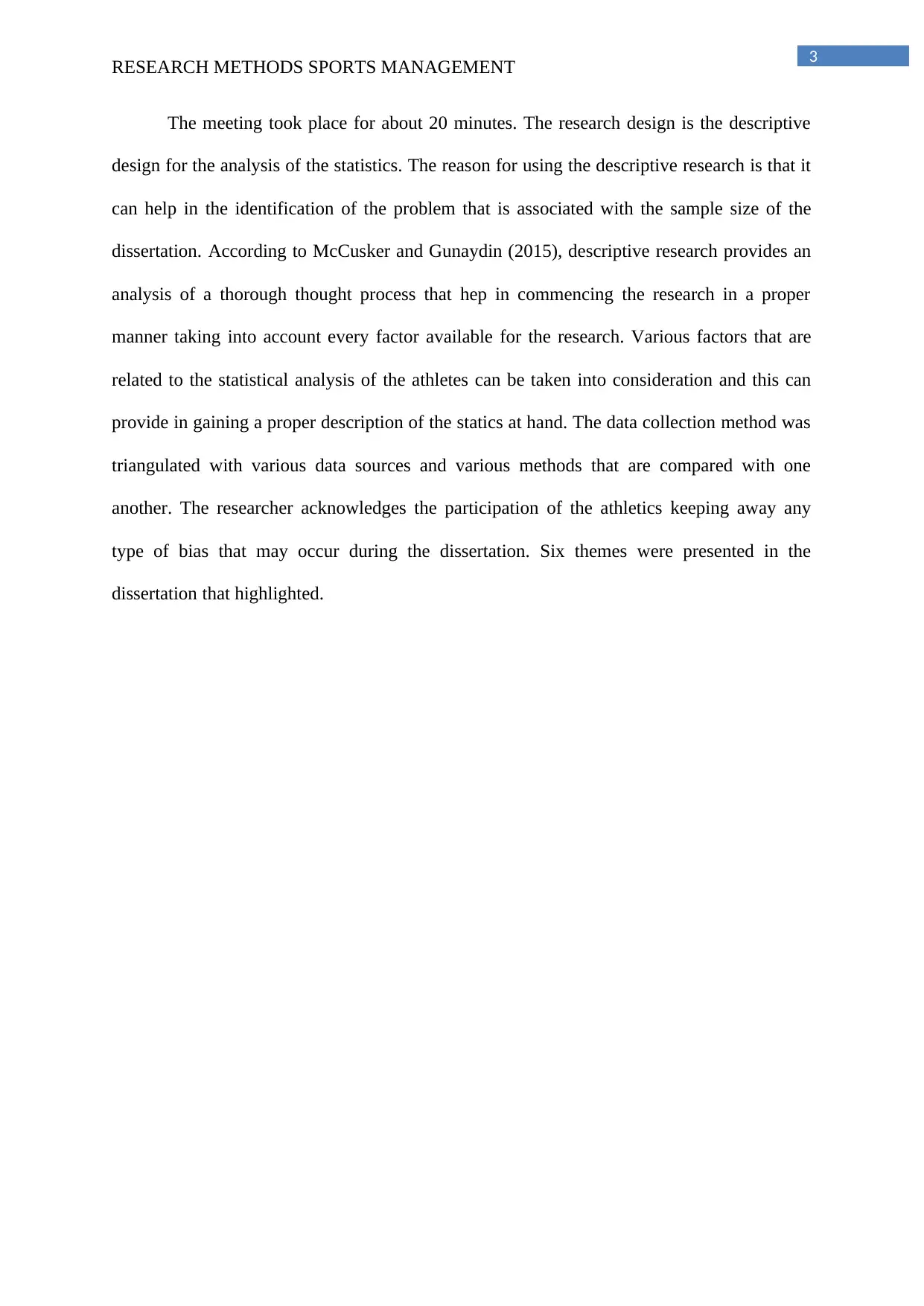SPT 501 Module 4: Research Design Review in Sports Management
VerifiedAdded on 2023/06/03
|5
|974
|407
Report
AI Summary
This report analyzes a sports management research study, comparing qualitative and quantitative research design approaches. The student examines a dissertation, detailing its research design, methodology, and data collection strategies, with a focus on the strengths and weaknesses of the study and justifies the choices made. The report contrasts the chosen design with potential alternative methods, considering how the design might influence the student's own research proposal. The analysis includes a discussion of the data collection methods used, such as interviews and focus groups, and identifies whether the research proposal will employ qualitative and/or quantitative data collection techniques. The paper also provides a table comparing quantitative and qualitative analysis and includes relevant references.

Running head: RESEARCH METHODS SPORTS MANAGEMENT
Research Methods Sports Management
Name of Student
Name of University
Author Note
Research Methods Sports Management
Name of Student
Name of University
Author Note
Paraphrase This Document
Need a fresh take? Get an instant paraphrase of this document with our AI Paraphraser

1
RESEARCH METHODS SPORTS MANAGEMENT
Concept of qualitative and quantitative research design approaches
Quantitative analysis:
This technique uses mathematics and statistics seeking to understand the behavior of
the people or the subjects. In most of the reports, a survey or interviews is conducted to get
the response of the subjects on the topic. Barnham (2015) has cited that quantitative analysts
use this technique to represent a said notion in terms of numerical value. Moreover,
quantitative analysis is used in case of evaluation of performance, measurement and valuation
of financial instrument. Brannen (2017) have added that in financial industry this technique is
used to evaluate the selling of opportunities. The application of numerical form of data can be
assessed in the form of quantitative analysis so that it can provide an idea of the topic in a
numerical manner.
Qualitative analysis:
This technique is based upon the subjective judgment founded upon unqualified
information given by managers or person of reliable information. Bryman (2017) defined
qualitative analysis as the process undertaking data on management expertise, labor relations,
strength of research and development focusing on number of government reports, balance
sheet, annual data and news paper information. Hartas (2015) are of opinion that qualitative
analysis mainly evaluates company data to reveal its competence and their investment
opportunity.
A comparison can be made between the two forms to summaries its application
Quantitative analysis Qualitative analysis
Concerned with understanding human
behaviour
Concerned with discovering facts
RESEARCH METHODS SPORTS MANAGEMENT
Concept of qualitative and quantitative research design approaches
Quantitative analysis:
This technique uses mathematics and statistics seeking to understand the behavior of
the people or the subjects. In most of the reports, a survey or interviews is conducted to get
the response of the subjects on the topic. Barnham (2015) has cited that quantitative analysts
use this technique to represent a said notion in terms of numerical value. Moreover,
quantitative analysis is used in case of evaluation of performance, measurement and valuation
of financial instrument. Brannen (2017) have added that in financial industry this technique is
used to evaluate the selling of opportunities. The application of numerical form of data can be
assessed in the form of quantitative analysis so that it can provide an idea of the topic in a
numerical manner.
Qualitative analysis:
This technique is based upon the subjective judgment founded upon unqualified
information given by managers or person of reliable information. Bryman (2017) defined
qualitative analysis as the process undertaking data on management expertise, labor relations,
strength of research and development focusing on number of government reports, balance
sheet, annual data and news paper information. Hartas (2015) are of opinion that qualitative
analysis mainly evaluates company data to reveal its competence and their investment
opportunity.
A comparison can be made between the two forms to summaries its application
Quantitative analysis Qualitative analysis
Concerned with understanding human
behaviour
Concerned with discovering facts

2
RESEARCH METHODS SPORTS MANAGEMENT
Data collected through participants Data collected through measuring things
Table: Comparison between Quantitative analysis and Qualitative analysis
(Source: Created by author)
Description of the research design used
In the dissertation written by Foye (2018) the methodology used for commencing the
research includes the qualitative study. The reason behind the selection of qualitative research
design is that the interviews that have been conducted are made up of head coaches. This can
help in understanding the manner in which the themes has been divided. At the same time the
application of the qualitative study provides an analysis of the numerical that are used in the
research so that the dissertation can be conducted using primary sources. Further analysis has
shown that the research method used for conducting the research is based on the sample size
of the population. Therefore, it can be said that overall the application of the qualitative
research is justified in this particular dissertation.
As seen earlier the sample size for the dissertation had been collected from all of the
17 Blue High School head coaches. Fifteen of the 17 of the sample size were teachers
whereas the other two head coaches work in industries that are different from the education
sector. The data collection method that was used for the completion of the dissertation is the
interview and the focus group study. The interview was conducted based on in-person and
each of the nine interviews were directly related to the three research questions. The
interviews lasted for about 20-25 minutes. 11 out of the 17 head coaches were interviewed for
the dissertation. In the case of the focus group study, four such coaches were gathered and a
meeting was commenced among one another. The duty of the focus group was to analyse the
student-athletes’ data based on the first marking period till the fourth marking period.
RESEARCH METHODS SPORTS MANAGEMENT
Data collected through participants Data collected through measuring things
Table: Comparison between Quantitative analysis and Qualitative analysis
(Source: Created by author)
Description of the research design used
In the dissertation written by Foye (2018) the methodology used for commencing the
research includes the qualitative study. The reason behind the selection of qualitative research
design is that the interviews that have been conducted are made up of head coaches. This can
help in understanding the manner in which the themes has been divided. At the same time the
application of the qualitative study provides an analysis of the numerical that are used in the
research so that the dissertation can be conducted using primary sources. Further analysis has
shown that the research method used for conducting the research is based on the sample size
of the population. Therefore, it can be said that overall the application of the qualitative
research is justified in this particular dissertation.
As seen earlier the sample size for the dissertation had been collected from all of the
17 Blue High School head coaches. Fifteen of the 17 of the sample size were teachers
whereas the other two head coaches work in industries that are different from the education
sector. The data collection method that was used for the completion of the dissertation is the
interview and the focus group study. The interview was conducted based on in-person and
each of the nine interviews were directly related to the three research questions. The
interviews lasted for about 20-25 minutes. 11 out of the 17 head coaches were interviewed for
the dissertation. In the case of the focus group study, four such coaches were gathered and a
meeting was commenced among one another. The duty of the focus group was to analyse the
student-athletes’ data based on the first marking period till the fourth marking period.
⊘ This is a preview!⊘
Do you want full access?
Subscribe today to unlock all pages.

Trusted by 1+ million students worldwide

3
RESEARCH METHODS SPORTS MANAGEMENT
The meeting took place for about 20 minutes. The research design is the descriptive
design for the analysis of the statistics. The reason for using the descriptive research is that it
can help in the identification of the problem that is associated with the sample size of the
dissertation. According to McCusker and Gunaydin (2015), descriptive research provides an
analysis of a thorough thought process that hep in commencing the research in a proper
manner taking into account every factor available for the research. Various factors that are
related to the statistical analysis of the athletes can be taken into consideration and this can
provide in gaining a proper description of the statics at hand. The data collection method was
triangulated with various data sources and various methods that are compared with one
another. The researcher acknowledges the participation of the athletics keeping away any
type of bias that may occur during the dissertation. Six themes were presented in the
dissertation that highlighted.
RESEARCH METHODS SPORTS MANAGEMENT
The meeting took place for about 20 minutes. The research design is the descriptive
design for the analysis of the statistics. The reason for using the descriptive research is that it
can help in the identification of the problem that is associated with the sample size of the
dissertation. According to McCusker and Gunaydin (2015), descriptive research provides an
analysis of a thorough thought process that hep in commencing the research in a proper
manner taking into account every factor available for the research. Various factors that are
related to the statistical analysis of the athletes can be taken into consideration and this can
provide in gaining a proper description of the statics at hand. The data collection method was
triangulated with various data sources and various methods that are compared with one
another. The researcher acknowledges the participation of the athletics keeping away any
type of bias that may occur during the dissertation. Six themes were presented in the
dissertation that highlighted.
Paraphrase This Document
Need a fresh take? Get an instant paraphrase of this document with our AI Paraphraser

4
RESEARCH METHODS SPORTS MANAGEMENT
Reference
Barnham, C. (2015). Quantitative and qualitative research: Perceptual
foundations. International Journal of Market Research, 57(6), 837-854.
Brannen, J. (2017). Mixing methods: Qualitative and quantitative research. Routledge.
Bryman, A. (2017). Quantitative and qualitative research: further reflections on their
integration. In Mixing methods: Qualitative and quantitative research (pp. 57-78).
Routledge.
Foye, D. (2018). Athletic Participation and Academic Achievement: A Perceptive Analysis of
Athletes’ Performance In-Season Versus Out-of-Season. Wilmington University
Hartas, D. (Ed.). (2015). Educational research and inquiry: Qualitative and quantitative
approaches. Bloomsbury Publishing.
McCusker, K., & Gunaydin, S. (2015). Research using qualitative, quantitative or mixed
methods and choice based on the research. Perfusion, 30(7), 537-542.
RESEARCH METHODS SPORTS MANAGEMENT
Reference
Barnham, C. (2015). Quantitative and qualitative research: Perceptual
foundations. International Journal of Market Research, 57(6), 837-854.
Brannen, J. (2017). Mixing methods: Qualitative and quantitative research. Routledge.
Bryman, A. (2017). Quantitative and qualitative research: further reflections on their
integration. In Mixing methods: Qualitative and quantitative research (pp. 57-78).
Routledge.
Foye, D. (2018). Athletic Participation and Academic Achievement: A Perceptive Analysis of
Athletes’ Performance In-Season Versus Out-of-Season. Wilmington University
Hartas, D. (Ed.). (2015). Educational research and inquiry: Qualitative and quantitative
approaches. Bloomsbury Publishing.
McCusker, K., & Gunaydin, S. (2015). Research using qualitative, quantitative or mixed
methods and choice based on the research. Perfusion, 30(7), 537-542.
1 out of 5
Related Documents
Your All-in-One AI-Powered Toolkit for Academic Success.
+13062052269
info@desklib.com
Available 24*7 on WhatsApp / Email
![[object Object]](/_next/static/media/star-bottom.7253800d.svg)
Unlock your academic potential
Copyright © 2020–2025 A2Z Services. All Rights Reserved. Developed and managed by ZUCOL.





